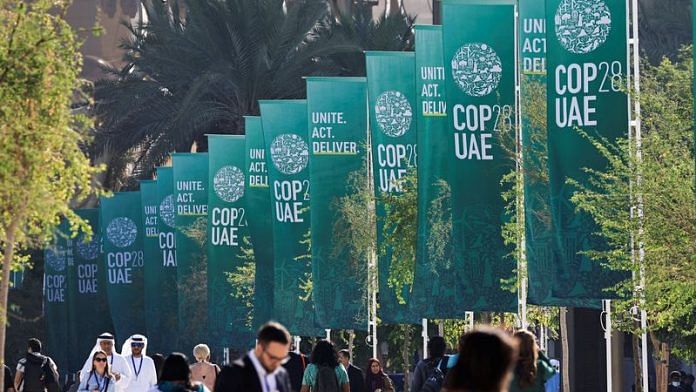World leaders came together at COP28 in Dubai to agree on ways to ensure a sustainable planet both now and in the future. On the fundamental level, the goal is to reduce the production and consumption of coal, gas, oil, and similar non-renewable resources. However, accomplishing this ambitious task requires taking a multifaceted approach, building scientifically sound targets, implementing cutting-edge technologies, and providing funds to expedite the transition to renewable energy. At the same time, global leaders must address complex social and political challenges.
Transitioning from an international framework, where various countries negotiate these parameters, to a domestic perspective underscores one requirement: An equitable distribution of the burden of transition among different firms within a country.
Complex chains pose a challenge
Consider the textiles industry in India. As one of the largest industrial sectors, both in terms of employment and the number of operational factories, it presents a unique challenge. The nature of the textiles and apparel value chain is complex across different clusters, with firms catering to foreign and domestic markets within the same cluster. Large exporting firms are more often vertically integrated and carry out all stages of production. On the contrary, small to medium firms specialise in a particular process like knitting or dyeing.
Energy accounts for 15-20 per cent of costs in the textile units in spinning, weaving, and processing units. It can range from 30-40 per cent for firms that print and dye fabrics. The main sources are the electrical energy from the state grid and thermal energy generated through burning wood, coal, or furnace oil. Some large exporting firms in India have committed to moving toward 100 per cent renewable energy, partly due to the push from the government and foreign buyers. Brands like H&M have committed to transitioning away from suppliers using non-renewable resources.
However, many large firms subcontract the most resource-intensive operations to micro, small, and medium-sized enterprises (MSMEs). This helps them to cut costs, given the fluctuations in orders and prices in the foreign and domestic markets. In this context, supporting energy-intensive MSME units (like those in wet processing) within the value chain becomes pivotal. Adopting energy-saving technologies in these units enhances the sustainability of the entire value chain.
Also read: India’s climate leadership test will come after COP28. Here’s how it can step up
MSMEs stay behind
Reports from the Bureau of Energy Efficiency (BEE) have underscored an information gap among MSMEs regarding the benefits of Energy Efficient Technologies (EETs) and improved operating practices. MSMEs, lacking a formal institutional structure, face barriers such as low-scale economies and either inadequate access to finance or a lack of innovative financing options tied to their production needs. Meanwhile, large firms have dedicated resources for energy management and in-house technical expertise that help them reduce their energy use per unit of production.
Moreover, the absence of a qualified workforce poses a significant obstacle to acquiring knowledge about innovations in the sector. Unlike large firms, MSMEs often focus on monthly energy bills and overall consumption without correlating the data with specific equipment efficiency or energy intensity of output. For instance, during a cluster visit, we observed that while larger firms monitor hourly coal consumption for every unit of fabric dyed, smaller firms prioritise achieving overall production targets in a given period.
This disparity underscores the need for monitoring tools, energy-efficiency practices, and data on performance benchmarks in various industrial processes within each sector. Precise measurement of energy consumption increases the likelihood of investment in energy-efficient technologies.
Further studies analysing the reasons for MSMEs’ non-adoption of energy efficiency technologies revealed that enterprise owners perceived unprofitability and risks in such investments and exhibited resistance to change and process disruptions. Studies also indicate a low participation rate in energy efficiency workshops, with a significant percentage of enterprises unaware of relevant technologies.
Also read: Developed nations got it wrong on climate damage fund at COP28. India is clear…
Workers’ plight
An important consequence of rising temperatures is increased heat exposure for factory workers. In their paper titled The Light and the Heat: Productivity Co-Benefits of Energy-Saving Technology, Achyuta Adhvaryu et al estimated the productivity consequences of adopting energy-saving technology (LED lighting) using daily production line-level data from large garment firms operating factories in and around Bengaluru. The factories initially used incandescent bulbs, and the emanating heat would increase temperatures on production floors, affecting workers’ productivity, especially on exceedingly hot days. Specifically, introducing LEDs eliminated roughly 85 per cent of the negative impact of temperature on worker efficiency during relatively hot days. It accounted for firm-wise productivity increases and shifted the overall break-even point for the firm from over three and a half years to less than eight months.
Thus, there are broader benefits of adopting energy-efficient technologies beyond the direct energy cost savings. Even when firms are aware of the direct cost savings, they are unaware of the indirect benefits due to efficiency gains. The latter can accrue by creating a better workplace ambience. This, in turn, can potentially result in productivity co-benefits for the firm with improved well-being and health of the MSME workforce.
COP28’s commitment to addressing the global climate crisis requires tailored strategies at the local level. Recognising diversity across and within industries and the hurdles faced by MSMEs in adopting energy-efficient technologies are key to overall success in energy transition. This not only contributes to environmental goals but also improves workplace conditions and worker well-being.
Sowmya Dhanaraj is a Senior Research Fellow, Good Business Lab. Views are personal.
(Edited by Humra Laeeq)



